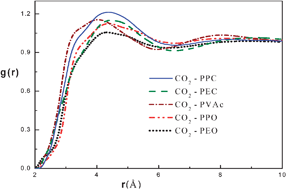A theoretical study of structure–solubility correlations of carbon dioxide in polymers containing ether and carbonyl groups†
Abstract
This work involves a theoretical study to investigate the effects of the structure on CO2

* Corresponding authors
a
The Key Laboratory of Carbon Fiber and Functional Polymers, Ministry of Education, Beijing University of Chemical Technology, Beijing 100029, PR China
E-mail:
duzj@mail.buct.edu.cn
Fax: +86-010-64438804
Tel: +86-010-64438804
b State Key Laboratory of Chemical Engineering, Department of Chemical Engineering, Tsinghua University, Beijing 100084, China
c
Laboratory of Computational Chemistry, Department of Chemical Engineering, Beijing University of Chemical Technology, Beijing 100029, China
E-mail:
mijg@mail.buct.edu.cn
Fax: +86-010-64412597
Tel: +86-010-64412597
This work involves a theoretical study to investigate the effects of the structure on CO2

 Please wait while we load your content...
Something went wrong. Try again?
Please wait while we load your content...
Something went wrong. Try again?
M. Xu, J. Chen, C. Zhang, Z. Du and J. Mi, Phys. Chem. Chem. Phys., 2011, 13, 21084 DOI: 10.1039/C1CP22671A
To request permission to reproduce material from this article, please go to the Copyright Clearance Center request page.
If you are an author contributing to an RSC publication, you do not need to request permission provided correct acknowledgement is given.
If you are the author of this article, you do not need to request permission to reproduce figures and diagrams provided correct acknowledgement is given. If you want to reproduce the whole article in a third-party publication (excluding your thesis/dissertation for which permission is not required) please go to the Copyright Clearance Center request page.
Read more about how to correctly acknowledge RSC content.
 Fetching data from CrossRef.
Fetching data from CrossRef.
This may take some time to load.
Loading related content
